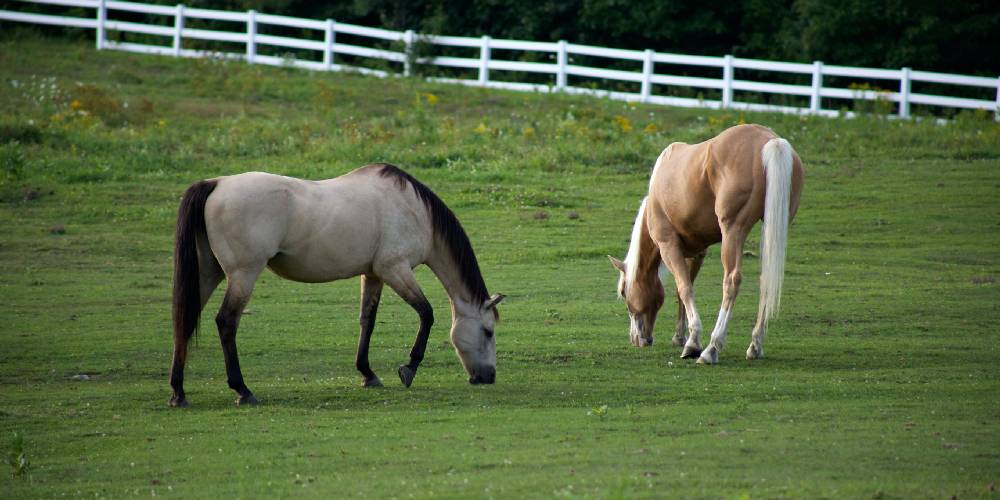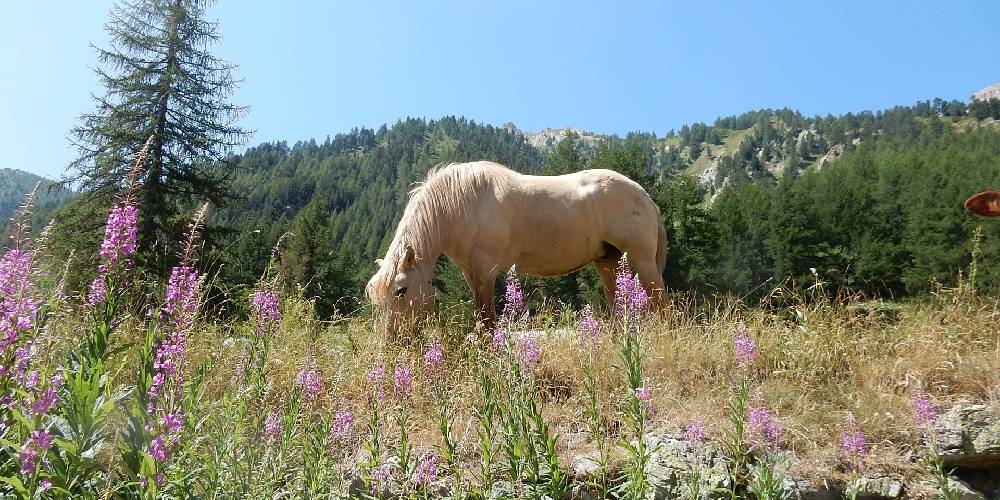Palomino horses are gorgeous animals with beautiful golden coats, but what makes this horse this color? And in what breeds are they most popular?
What Is Palomino?
Palomino is a horse coat color NOT a horse breed that is caused by the influence of something known as the creme gene. Palominos are just chestnut horses that carry one copy of the creme gene which is what dilutes their color. Palomino horses are most commonly seen in breeds used for western riding like the Quarter Horse, but this color can be seen in many more breeds than this. Palominos are mainly found in the United States of America and are prized for their gorgeous golden coloration.
What Creates The Palomino Coat Color?

There are two things that are necessary to create the Palomino coat color. These two things are:
- Chestnut Base Color
- One Creme Gene
These two things are absolutely necessary in creating the Palomino.
If you are wanting to breed horses to create the Palomino coat color, breed one horse carrying mainly or only chestnut genetics to a Cremello horse. This way, the Cremello horse can give one creme gene to the chestnut offspring thus creating a Palomino foal.
How Can A Palomino Horse Be Identified?

There are multiple ways to identify a horse as a Palomino. The ways to tell are:
Looking At Genetics
Looking at the genetics of a horse is one of the easiest ways to determine what color they truly are. If you look at the genetics of the Palomino, you should see that they carry the base color of chestnut, but have their light color because of one copy of something known as a creme gene. The creme gene reduces the pigmentation of a horse’s coat thus making it lighter.
Noting The Color Of The Mane & Tail
Palomino horses usually have a white mane and tail, though sometimes it can be seen in more of a beige color.
Looking At The Coat Color
Palominos can range from a deep brassy-copper color to a light creamy gold color, but overall they should be a light tan shade.
Determining The Horse’s Skin Color
Palomino horses will always have black skin. You can tell if a horse has black skin by looking at the color of their muzzle and the skin around their eyes. If their muzzle and the skin around their eyes is dark or black, the horse has black skin.
What Is The Difference Between Palomino & Cremello?
There are only two true ways to tell the difference between a Palomino horse and a Cremello horse. These are:
Looking At Genetics
When looking at the genetics of a Cremello horse, there are two creme genes present in their genetic makeup as well as the genetics for a chestnut coat color. This is similar to that of a Palomino when looking at the chestnut genes and creme genes, only Palomino horses will only have one creme gene present as compared to the two that a Cremello horse would carry.
To learn more about the Cremello Horse color, click here!
Looking At Overall Color
When looking at the coat colors of these horses, you might notice that both of these horses have a golden coat. The Cremello will usually have a creme or pearl colored gold shade to their coat while the Palomino will have a deeper golden-copper color to their coat.
One trait that both of these horses share is their white manes and tails. Both Cremello horses and Palomino horses will have a white mane and tail.
Another way to tell these two horses apart is by looking at their skin colors. Cremello horses, thanks to the double dilution caused by the creme gene will have pink skin all over their bodies. Because the Palomino only has one creme gene, just their coat and mane colors were changed and diluted meaning their skin remains the typical black seen in most horse colors.
How Can I Tell The Difference Between Buckskin & Palomino?

Buckskin and Palomino horses are easy to tell apart though they do share some things in common. The two main ways to tell them apart are by:
Looking At Genetics
Both of these horses carry creme genes. Though it may be kind of surprising, the buckskin actually does have quite a lot of dilution. Buckskin horses carry one copy of the creme gene and the base genetics of a bay horse while Palomino horses carry one copy of the creme gene and the base genetics of a chestnut horse.
Looking At Overall Color
Buckskin horses have much darker features that those of Palomino horses. This can be seen when looking at their mane and tail, ears, and legs.
Buckskin horses carry the black mane and tail over from their bay genetics while Palomino horses carry a white mane and tail.
Palomino horses usually are just seen with golden ears, the same color as the rest of their body, while buckskin horses tend to have ears with black or dark colored rims and edges.
The legs seen on buckskin horses are also similar to the legs of bay horses. Buckskins have black legs while Palominos are just one consistent color that carries over from their body, meaning their legs are gold as well.
I previously have written an article all about the differences between Palominos and Buckskins. To learn more about the differences, click here!
How Can I Tell The Difference Between Chestnut & Palomino?

It can be really easy to tell the difference between chestnuts and palominos, unless you are looking at a coat color known as a light flaxen chestnut. Light flaxen chestnut horses can look exactly like Palominos so knowing the difference can be important.
Chestnut horses are usually reddish brown in color with the same color mane and tail while Palominos are golden and carrying a white mane and tail. The only time it gets tricky is if a chestnut is a light flaxen color. Light flaxen chestnuts can look identical to Palominos, with the only difference being that they DO NOT carry a creme gene. This is the only difference. Sometimes, you might need to genetically test your horse if you are unsure which coat color they are.
To read more on chestnut horses, click here!
Can Palomino Horses Have White Markings?
Absolutely! It is very common to see Palominos with white markings on both their faces and their legs. My first horse was a Palomino and she had two white socks on her legs and an interrupted stripe on her face. The markings that Palominos can have include:
- Stars
- Stripes
- Snips
- Interrupted Stripes
- Blazes
- Socks (includes coronet, half pastern, fetlock, half-cannon, and cannon markings)
- Stockings (includes any over-the-knee markings)
Are Palomino Horses Rare?

Though Palomino horses aren’t considered rare, they aren’t extremely common either. These horses are actually frequently seen in a variety of competitions, especially competitions that involve Quarter Horses, as it is the Quarter Horse breed that carries most of the Palomino horses in the world. The reason that this color isn’t more popular is that many breeds don’t actually accept this color into their registry when it comes to purebred horses.
Breeds that Can’t Be Palomino
There are several breeds that can’t be Palomino to be classified as a preubred horse. this includes:
- Arabians
- Cleveland Bays
- Belgians
- Haflingers
- Fjords
- Clydesdales
Breeds That Can Be Palomino

Palomino horses can be seen in a number of breeds and as the popularity of this color grows, more and more breeds are beginning to allow it. Examples of breeds thast allow the Palomino color are:
- Quarter Horses
- Mustangs
- Andalusians
- Missouri Fox Trotters
- Saddlebreds
- Tennessee Walking Horses
- Thoroughbreds
- Akhal-Tekes
- Paint Horse
Can The Palomino Coat Color Effect The Horse’s Health?
Unfortunately, yes. Palomino horses, because of their light color, are more sensitive to the sun than other breeds that carry more pigmentation. These horses are more prone to sun burn, skin cancer, and other cancers.
This is actually how I lost my first horse Show-Me. I will tell my story further below.
Fun Facts On Palominos

- Because Paint Horses can be Palomino, sometimes Palominos are seen with white patches.
- A Palomino foal is guaranteed by crossing a Cremello horse with a fully chestnut horse
- Did you know that the Quarter Horse breed carries over half of the world’s Palomino horses??
- Palomino horses, because of their golden color, was reserved only for royalty
FAQs On This Coat Color
Are Palominos a breed of horse?
NO! Palomino is strictly a coat color as there is not a specific breed of horse that comes only in this color and many breeds can be seen as Palomino.
Do Palominos actually change color?
Yes, Palominos can change color. These horses can be lighter in winter due to their winter coat growing in, they also can acquire dapples depending on their diet, and when their coat is full shed out in summer, they will appear to be more bright and brassy. All throughout their life and through the years the color of this horse’s coat will change.
Is there such thing as a Palomino Roan?
Yes there is! Palomino Roans have very unique genetics that include chestnut, creme, and roan genes.
I actually talk a little bit about Palomino roans in my roan horse article. You can read about them by clicking here!
My Experience With Palominos
My first horse was actually a Palomino mare by the name of Show-Me. She was a gorgeous Missouri Fox Trotter at the ripe old age of 23. I had ridden her since the age of 10 and she was eventually given to me when I was 14 years old. Show-Me was the sweetest and best behaved horse I have ever met and she wouldn’t spook, buck, or do anything unpredictable. Sadly, however, my perfect little horse was only mine for three months.
On January 2nd, my poor Show-Me began to colic. Eventually, after calling out three different equine veterinarians, we discovered a baseball sized mass in her intestines. The mass had a thread attached to it that had wrapped itself tight around her intestines cutting off blood flow, air flow, and the flow of manure. On the night of January 2nd, she was euthanized.
It was so so hard to lose such a great horse that I had known for so long, but we knew putting her out of this uncureable pain was what needed to happen.
I later learned that this tumor she carried in her body was possibly related to her coat color. Because light-colored horses get more exposure overall, they are more likely to suffer from cancer and other health issues like Show-Me did.

